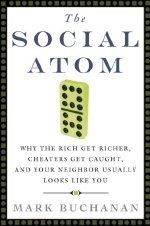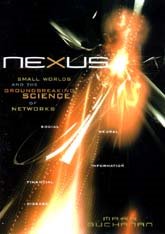One of the most basic ideas of social atomics is that patterns are often more important than people. Here's a really simple example. Think of a crowded sidewalk with people moving in both directions -- some to the left, say, and some to the right. If you've been out shopping over Christmas, you've probably been in a situation like this. Each person walks according to their own independent aims, yet what you typically find emerging in such situations is a natural segregation of the human traffic into well-defined lanes moving in either direction. You can see a nice simulation of the process here on the website of the German physicist Dirk Helbing. The blue arrows represent people moving to the right, and the red people moving left. In the simulation, the walkers start out mingling at random, but over time lanes naturally emerge.
You can ponder the depths of individual human complexity all you like and never explain this -- because these lanes emerge all on their own, without anyone intending to make them. The explanation has to do with pattern and what creates it, not the nuances of individual psychology. Here's the basic story. When people walk they go where they want to go, except for one thing -- they generally try not to run into others. This is an obvious fact, yet it has not-so-obvious consequences. When two people meet, one or both need to shift sideways a little (either up or down in this case) to get past one another. This is enough to generate the organization. That's because when people shift sideways to avoid a collision, they'll continue shifting so long as they continue to encounter people heading in the opposite direction. They'll only stop shifting and go forward again when they find other people heading in their own direction. As a consequence, people tend to get bounced sideways until they find and join a lane moving in their direction. Any lane that forms, even by accident, will tend to persist and grow.
This is a simple, indeed trivial example, involving only our very rudimentary behaviour when walking. The really interesting thing is to wonder whether similar kinds of patterns might not influence our lives in other areas -- in the words we use, the thoughts we think and opinions we hold. There well may be patterns and social streams that carry us along much as these lanes to pedestrians. The point of social physics is to try to identify such streams, learn where they come from and what controls their formation, and to see how they influence our lives.
Friday, December 29, 2006
A simple example
Wednesday, December 27, 2006
What's the idea? Think pattterns, not people
Can we can ever learn to understand people and societies, businesses and other groups of all sorts, the same way we do atoms and molecules and the physical matter they make up? Are we ever going to have something like "social physics"? For centuries, philosophers and social scientists of all stripes have come up with thousands of explanations as to why we cannot; why people are essentially different and somehow stand apart from the rest of nature. The very idea of social physics, they say, is an absurdity and that's all there is to it.
Of course, we all know that people are notoriously unpredictable (or so we hear), and human psychology is immensely complicated (which is true enough). But....it seems that modern science is beginning to prove that all this talk of impossibility is probably way overblown and very, very mistaken. I've just finished writing a book called The Social Atom, due to be published by Bloomsbury Press in the U.S. in May, 2007. The book offers a snapshot, illustrated with plenty of stories, of an exploding new area of research which has shown that social physics is possible, and that science can bring the human world within its grasp -- even in strict mathematical terms.
As a book is inherently limited in what it can cover, I've started this blog as a way of taking a closer look at some of the real-world examples in the book, and as a way to explore related ideas and examples that I either didn't have space to mention there or I've learned about since then. The book covers the beginnings of a very important new movement in science -- but most of the good stuff is surely yet to come!
I think the most important idea in the entire book is the notion that our primary obstacle to understanding the human social world is our tendency to fixate on the complexity of the human individual. When we see some social surprise that we can't understand -- a riot, a sudden wave of social protest, some crazy and seemingly senseless new fashion or the unexpected collapse of a great company -- and we often think that it's the baffling behaviour of the people involved, as individuals, that leads to our puzzlement. But the real reason is often quite different -- it is not the people as individuals that confound us, but the collective social patterns that well up among them. Even if people were completely simple automatons -- with all their behaviour fully and easily predictable -- we'd still often be confused by the amazing and surprising things that happen when you put 10 or 100 of them together.
The truth is that we lack all but the most rudimentary capacity for understanding the patterns of social behaviour that emerge in our world or why they emerge so readily. In other words, we've been trained to think in exactly the wrong way. This surely sounds awfully vague and maybe a little doubtful. But it isn't, as I hope future posts will begin to make clear...
Of course, we all know that people are notoriously unpredictable (or so we hear), and human psychology is immensely complicated (which is true enough). But....it seems that modern science is beginning to prove that all this talk of impossibility is probably way overblown and very, very mistaken. I've just finished writing a book called The Social Atom, due to be published by Bloomsbury Press in the U.S. in May, 2007. The book offers a snapshot, illustrated with plenty of stories, of an exploding new area of research which has shown that social physics is possible, and that science can bring the human world within its grasp -- even in strict mathematical terms.
As a book is inherently limited in what it can cover, I've started this blog as a way of taking a closer look at some of the real-world examples in the book, and as a way to explore related ideas and examples that I either didn't have space to mention there or I've learned about since then. The book covers the beginnings of a very important new movement in science -- but most of the good stuff is surely yet to come!
I think the most important idea in the entire book is the notion that our primary obstacle to understanding the human social world is our tendency to fixate on the complexity of the human individual. When we see some social surprise that we can't understand -- a riot, a sudden wave of social protest, some crazy and seemingly senseless new fashion or the unexpected collapse of a great company -- and we often think that it's the baffling behaviour of the people involved, as individuals, that leads to our puzzlement. But the real reason is often quite different -- it is not the people as individuals that confound us, but the collective social patterns that well up among them. Even if people were completely simple automatons -- with all their behaviour fully and easily predictable -- we'd still often be confused by the amazing and surprising things that happen when you put 10 or 100 of them together.
The truth is that we lack all but the most rudimentary capacity for understanding the patterns of social behaviour that emerge in our world or why they emerge so readily. In other words, we've been trained to think in exactly the wrong way. This surely sounds awfully vague and maybe a little doubtful. But it isn't, as I hope future posts will begin to make clear...
Friday, December 15, 2006
Physics of the social world
It's long time we humans got a little more scientific about ourselves...we're not so different from the rest of nature after all...
Subscribe to:
Posts (Atom)



